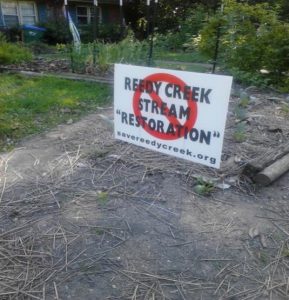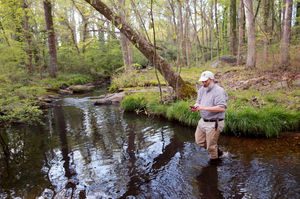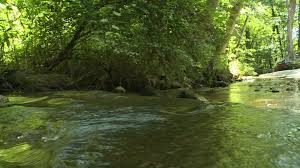Instead of being sound asleep in a warm comfy bed at 8am on a Thursday morning, 2 weeks ago, we were cooped up in a University van, on our way to Reedy Creek. As we got closer and closer to our final destination, we came across signs upon signs promoting the stopping of the Reedy Creek Restoration. In fact, numerous front yards even hosted 3 or 4 of these signs, as if taunting the officials involved in restoring the Creek to come talk to them and hear what they have to say. The community seemed to be aware of how detrimental this restoration effort could be to their local creek.
Through the Reedy Creek Restoration, the local government plans to “repair and improve 2200 feet of the creek, restoring the original creek bed while reducing stream bank erosion and nutrient pollution…resulting in a cleaner James River and Chesapeake Bay.” However, as Bill Shanabruch mentioned during our excursion, this plan is unnecessary, as it fails to address the root of the problem—high volumes of sediment-filled stormwater runoff flowing downstream. On top of that, trees will be cut down, park property and historic sites will be destroyed, and tax payer dollars will be wasted on a project that is hard to maintain overtime. It is essentially a lose-lose situation, or, as Parr states, “the Reedy Creek “Restoration” seems to be nothing more than a government project to just “check off the box” and say they did something beneficial, without actually looking into the details.”
Nevertheless, I was extremely impressed by how successful the Reedy Creek Coalition was in spreading word about the restoration. In fact, they were actually the most successful organization in terms of spreading information about a community-involving situation that I have ever seen, as almost every house we passed seemed to have at least one of the “Reedy Creek Stream “Restoration”” signs. As Dr. Forsyth wrote about in his Awareness-Appraisal model, if one is not even aware of something such as the presence of a local stream or river, or, in this case, the presence of a potential restoration effort to a local creek, it is impossible to appraise the situation and then take necessary actions to fight the restoration efforts. In this sense, Reedy Creek Coalition is on the right path to potentially overturning the restoration project.



